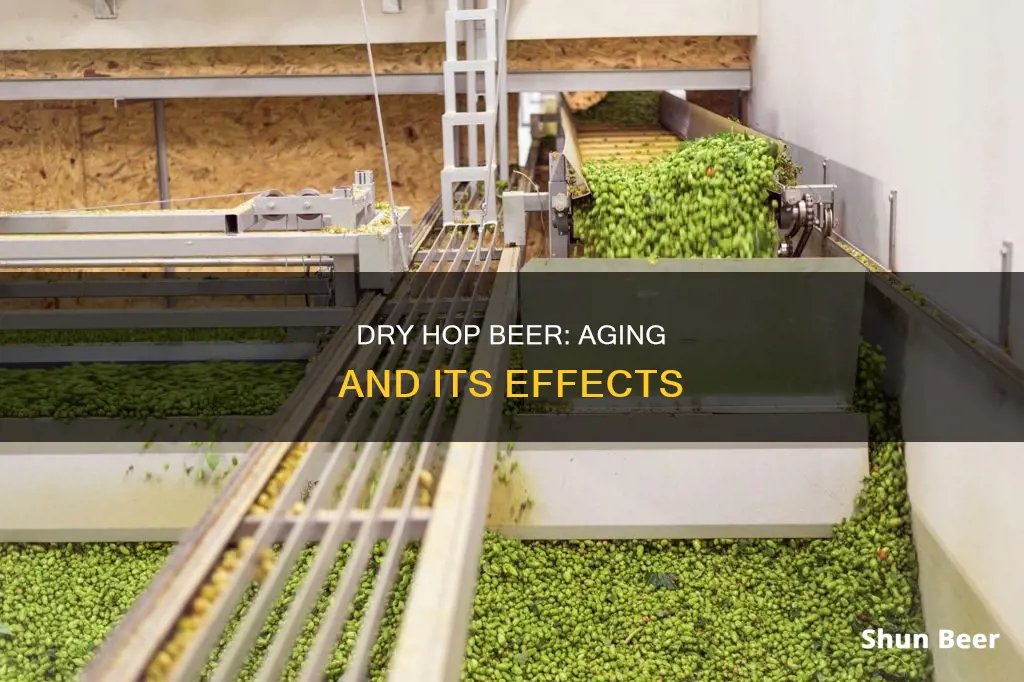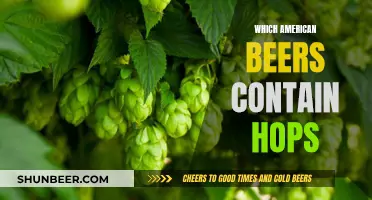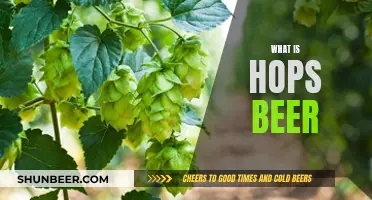
Dry-hopping is a popular brewing technique used to impart a fresh hop aroma and flavour to beer. It involves adding hops to fermented beer, typically during or after primary fermentation. The process helps to prolong precious hop aromas and enhance the flavour and aroma of the beer without making it bitter. The timing of dry-hopping can vary from a few days to a few weeks and different types of hops can be used depending on the desired flavour profile. While dry-hopping can add intensity to the beer, there are some potential drawbacks such as bacterial contamination and a grassy or oily taste. Overall, dry-hopping is a great way for brewers to experiment and add unique characteristics to their beer.
| Characteristics | Values |
|---|---|
| Etymology of the term "dry-hopping" | The term "dry-hopping" may be lost to history. Some theorize that at one time, hops came into the brewery fresh, and were used fresh on brew day. Then, when hops from that same batch were added 7 or more days later, the hops had dried out. Others say the term developed because the brewer is adding them at a time when hops no longer touch liquor (brewer's term for water) or wort, the process requiring only tossing dry hops into a fermenter. |
| Purpose of dry-hopping | Dry-hopping is the primary method used by brewers to impart tantalizingly fresh hop aroma into styles ranging from Pilsner to Double IPA. |
| Alpha acids | Alpha acids are the compound in hops that make beer bitter. |
| Iso-alpha acids | Iso-alpha acids provide hop bitterness in beer. |
| Hop essential oils | Hop essential oils contain aroma compounds that supply myriad flavors including "dank," tropical, vinous, or fruity. |
| Polyphenols | Polyphenols that cause astringency, a drying or rough mouthfeel, can be extracted during prolonged exposure to the vegetal matter of hops. |
| Timing of dry-hopping | In a relatively new method, brewers are dry-hopping during primary fermentation to brew the (in)famous New England IPA (NEIPA) style. |
| Double dry-hopping (DDH) | Double dry-hopping means different things to different brewers. For some, it means adding hops at both during fermentation and then again after fermentation. For others it means doing two dry-hop additions at any time. |
What You'll Learn

Dry hopping adds aroma and flavour without bitterness
Dry hopping is the process of adding hops to beer after fermentation has begun. It adds aroma and flavour without any bitterness. Hops contain compounds called alpha acids. When alpha acids are heated during the boil, they undergo isomerisation, which provides the beer with bitterness. Boiling hops for a longer period of time leads to more isomerisation and a more bitter finished beer.
Dry hopping preserves the delicate volatile oils that produce flavour and aroma. These oils do not survive a boil. During the boiling process, nearly all of the hop oils evaporate. The hops put in at the beginning of the boil for bittering lose almost all of their oils. Those added near the end of the boil don't lose as much oil but still lose quite a bit. The heat of the boil induces chemical changes in the oils, so even those that are left lack the aroma of fresh hops.
The term dry hopping originated centuries ago with British brewers and was used to refer to adding hops to the cask shortly before it was shipped off to the customer. Nowadays, dry hopping refers to any hop addition after the wort has been cooled. These additions can be done in the primary fermenter, in the secondary, or by adding hops directly to a keg.
The benefit of dry hopping is that the brewer can get as much flavour and aroma as possible into the final beer. This can give your beer a floral hop essence and an intense flavour that is desirable in hoppy beer styles like pale ales and IPAs.
What dry hopping does not add to the beer is bitterness. Boiling is necessary to convert the alpha acids in the hops to iso-alpha acids to create bitterness. To maintain your desired bitterness, you still need to add the bittering hops to the boil.
The only other drawback to dry hopping is that some beer drinkers just don’t like the effect. They think it makes the beer taste “grassy” or “oily.” This method definitely gives a different kind of flavour and aroma than the traditional method of adding hops to the boil, but if you like any of the commercially dry-hopped beers mentioned, you will probably like it in your homebrew as well.
Hops in Beer: Friend or Foe for Sore Throats?
You may want to see also

Dry hopping can be done during or after fermentation
Dry hopping is the process of adding hops (dried whole leaf or T-90 pellets) to beer after the boil, typically during or right after primary fermentation. This technique adds aroma and flavour without introducing bitterness.
When to Dry Hop
During Primary Fermentation
Dry hopping during primary fermentation is common practice for IPAs. The active yeast will reduce hop oil compounds but transform others into new and distinctive ones that impart floral flavours and aromas. This process is called biotransformation.
However, if hops are added too early during active primary fermentation, the biotransformation process could decrease. Therefore, it is recommended to add hops towards the end of primary fermentation.
After Primary Fermentation
Dry hopping after fermentation may result in a different environment for the hops. The vigorous CO2 bubbling of primary fermentation is finished, so the hops won't lose their aroma compounds to scrubbing. Additionally, bacterial contamination is less of a threat as the wort has a higher alcohol content, less available oxygen, and lower pH.
However, the biggest risk of dry hopping after fermentation is the introduction of unwanted oxygen, which can cause oxidation. There is also a risk of "hop creep", where dry-hopping results in more fermentation and a higher alcoholic beer than intended.
How Long to Dry Hop
The ideal period for dry hopping is within 48 to 72 hours. Longer durations may result in the loss of essential oils and aromas, and increase the presence of polyphenols, which can negatively affect flavour.
Hop Butcher's Lactose: A Universal Addition?
You may want to see also

Dry hopping can be done in the primary or secondary fermenter, or in the keg
When it comes to dry hopping, brewers have a few options regarding timing and vessel choice. Dry hopping can be done in either the primary or secondary fermenter, or even directly in the keg. Each method has its own advantages and considerations:
Dry Hopping in the Primary Fermenter:
Adding dry hops to the primary fermenter is often done towards the end of primary fermentation. This method allows the yeast to absorb and process some of the hop oils, which can help reduce any grassy or vegetal flavors that fresh hops may contribute. It's important to ensure that fermentation is nearly complete before adding the dry hops, as active fermentation can scrub out some of the delicate hop aromas. Leaving the beer on the dry hops for 3–5 days is usually sufficient to impart the desired flavors and aromas.
Dry Hopping in the Secondary Fermenter:
This method is often chosen when the brewer wants to focus solely on imparting hop character without the potential yeast interaction. By adding dry hops to the secondary fermenter, the beer has already completed primary fermentation, and the yeast has settled out. This means that the hops will have less interaction with the yeast, resulting in a purer expression of hop character. The duration of dry hopping in the secondary can vary, but 5–7 days is a common range.
Dry Hopping in the Keg:
For those who want fresh, vibrant hop aromas, dry hopping directly in the keg is an excellent option. This method is often used for hop-forward styles like New England IPAs or hazy pale ales. By adding dry hops to the keg, the hops remain in constant contact with the beer, continuously imparting their character. This method is best suited for beers that will be consumed quickly, as the hops can start to degrade and impart unwanted flavors if left too long.
Regardless of the chosen method, the type of hops used, and the specific beer style, are important considerations. Different hop varieties have varying oil contents and will contribute different aromas and flavors. Additionally, the base beer style should complement the dry hopping process. For example, a heavily dry-hopped stout might not showcase the hops as effectively as a lighter-colored, less robust style.
Finally, when discussing dry hopping and beer aging, it's important to note that dry-hopped beers are typically meant to be consumed fresh. While they can be aged, the delicate hop compounds that provide the desired aromas and flavors will oxidize and degrade over time. This can lead to muted hop character and the potential development of off-flavors. So, while dry hopping can be done at different stages of brewing, it's generally recommended to enjoy dry-hopped beers within a few months of packaging to capture the full impact of the hops.
Hops: Brewing Demand and Future Growth
You may want to see also

Dry hopping can be done with whole cone, pellet or cryo hops
Dry hopping is the process of adding hops during or after fermentation, which gives your beer a blast of floral and fruity flavours and aromas. The essential oils in the hops are preserved, and the beer's bitterness is not impacted. There are a few different types of hops that can be used for dry hopping, each with its own advantages and disadvantages:
Whole Cone Hops
Whole cone hops have the freshest flavours and best aromas of the three types. However, they have a limited shelf life and take up a lot of space, as a larger amount is needed compared to pellets. Whole cone hops also create more crevices for oxygen to enter, increasing the risk of oxidised beer. They float as well, further raising the risk of oxygen contamination. This issue can be addressed by weighing down the hops bag with well-sanitised stainless steel washers or marbles.
Pellet Hops
Pellet hops are more convenient and readily available. They are also more efficient, as they have a longer shelf life and are less likely to harbour bacteria. Commercial breweries tend to use this type of hops, as they have advantages such as shelf life, efficiency, and less beer absorption. However, pellet hops usually contain lower concentrations of essential oils than whole cones, and they can give a grassy taste to the beer if left for too long.
Cryo Hops
Cryo hops are a type of concentrated hop pellet that adds more intense aroma and flavour to the beer. They are created by freezing hop cones with liquid nitrogen and then separating the lupulin glands (which contain the concentrated bittering and oil portion) from the leaf. This results in a more concentrated final product. Cryo hops require fewer hops compared to standard pellets, which means less beer loss from heavily dry-hopped beers.
Hops in Beer and Vinegar: What's the Connection?
You may want to see also

Dry hopping for 48-72 hours is ideal
Dry hopping is the process of adding hops to beer after primary fermentation. The ideal time for dry hopping is within 48 to 72 hours. This is because, after 24 hours, the aroma compounds of the hop oils are fully extracted into the beer. Leaving the hops in the beer for longer than 72 hours will not increase important essential oil and aroma extraction. In fact, it may lead to negative effects.
Leaving the hops in the beer for longer than 72 hours may lead to the extraction of polyphenols, which can cause astringency and a drying or rough mouthfeel. It may also lead to "hop creep", a phenomenon where dry-hopping results in more fermentation, leading to a higher alcoholic beer than intended.
Therefore, dry hopping for 48-72 hours is ideal.
Bock Beer and Hops: A Complex Relationship
You may want to see also
Frequently asked questions
The ideal period for dry hopping is anywhere within 48 to 72 hours. Any longer, and you risk losing essential oils and aromas, and you may also encounter "hop creep," which can affect the beer's quality.
Dry hopping enhances the aroma and flavor of your beer without adding bitterness. It allows you to take advantage of different hop varieties to yield complex flavor profiles.
Dry hopping can introduce the risk of bacterial contamination since the hops are not boiled and sanitized in the same way as the rest of the brew.







